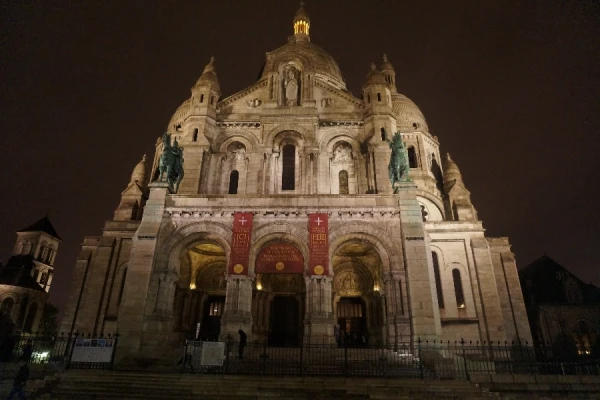
Rome Newsroom, Oct 28, 2020 / 12:00 pm (CNA).- Sacré-Cœur Basilica in Paris is expected to be classified as a protected historic monument by France’s Minister of Culture.
The Catholic basilica, which is dedicated to the Sacred Heart of Jesus, is one of the most visited sites in Paris, and since August 1, 1885, has been home to perpetual Eucharistic adoration.
“The Sacré-Cœur is one of the symbols of Paris,” Laurent Roturier, the director of France’s cultural affairs office, said. “It has been the most-visited building in Paris since Notre-Dame has been in repair.”
“But even more astonishing is that it is not protected as a historic monument. This is a sign of the slow recognition of 19th-century architecture,” he added.
The basilica celebrated the 100th anniversary of its consecration last year. Before the coronavirus pandemic, it received an average of 10 million visitors per year.
It sits on Paris’ second-highest hill, Montmartre, the site of the torture and martyrdom of St. Denis and companions. The first stone of the basilica was laid in 1875, with the basilica’s inauguration taking place in 1891. The bell tower was finished in 1914.
There is a widespread belief that Sacré-Cœur was built in expiation of the violence which took place during the Paris Commune, a socialist and anti-religious revolutionary government that ruled the city of Paris for just over two months in 1871.
But French historian Patrick Sbalchiero told Le Figaro this is a “historical error.”
He asserted that, while the construction of the basilica began under Pope Leo XIII in 1875, the text of the National Vow implementing the future worksite was drafted before the Commune. The members of the Committee of the National Vow were motivated by their Christian faith and highly engaged in charitable activities, he said.
Sbalchiero commented that the classification of Sacré-Cœur Basilica as a historic monument would “undoubtedly” help it to be better preserved.
From 2015 to 2020, France gave 14.4 million euros to religious sites protected as historic monuments.
Sacré-Cœur Basilica was evaluated for inclusion in the register of historic monuments by a regional heritage group, the Commission régionale du patrimoine et de l’architecture d’Île-de-France, which “returned a unanimous positive opinion for registration to the list of historic monuments, and unanimously expressed a wish for classification,” Roturier said.
The Catholic basilica will also be examined by a national heritage group, the Commission nationale du patrimoine et de l’architecture, before receiving the classification in a decree from France’s Minister of Culture.
According to the basilica’s website, one of the many people who found solace in the church was Blessed Charles de Foucauld. The pioneering French missionary, who is expected to be canonized soon, consecrated himself to the Sacred Heart in the basilica in June 1889.
He returned from Africa in 1909 and spent a night of Adoration there with his friend, Louis Massignon. He later recalled the evening as a time of grace.
Fr. Stéphane Esclef, Sacré-Cœur’s rector, said that, with the basilica’s classification as a historic monument, he hoped the church would “be ever more a haven of peace and consolation for all those who need it. That everyone, skeptical, curious, believer or not, can come and leave their joys, their hopes, their sorrows and their distresses.”
He quoted Cardinal Jean-Marie Lustiger, who wrote in a preface to a book about the basilica that “any Parisian, any visitor to the capital, can say to himself by seeing on the horizon the white domes of the Sacré-Cœur de Montmartre, that up there, at this moment, we pray for him, for all those he meets and for the whole world.”
“May everyone in this place know that a heart awaits him,” Esclef said. “An open heart, ready to console and tell him that he is loved. A gentle and humble heart. That of Jesus. A Sacred Heart.”
If you value the news and views Catholic World Report provides, please consider donating to support our efforts. Your contribution will help us continue to make CWR available to all readers worldwide for free, without a subscription. Thank you for your generosity!
Click here for more information on donating to CWR. Click here to sign up for our newsletter.




turned into a museum just like hagia sophia was, then into a mosque.